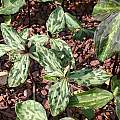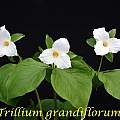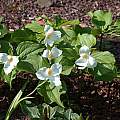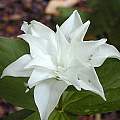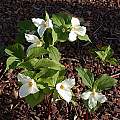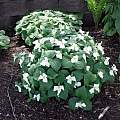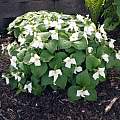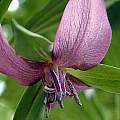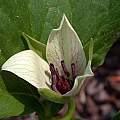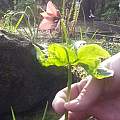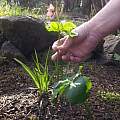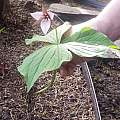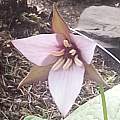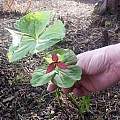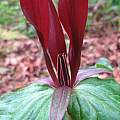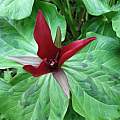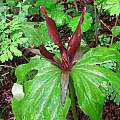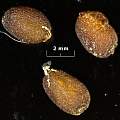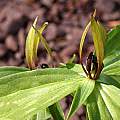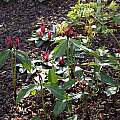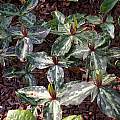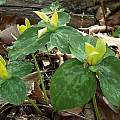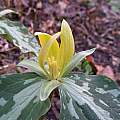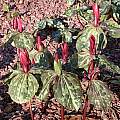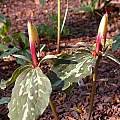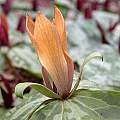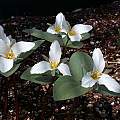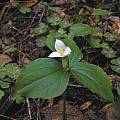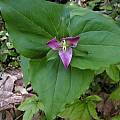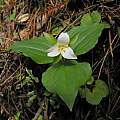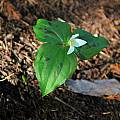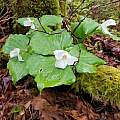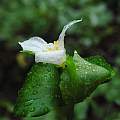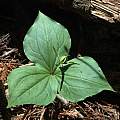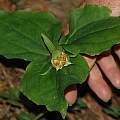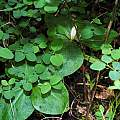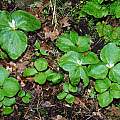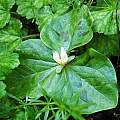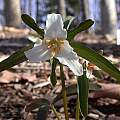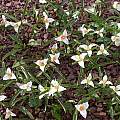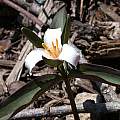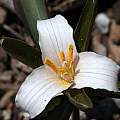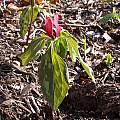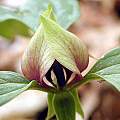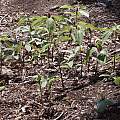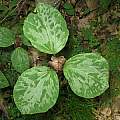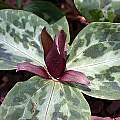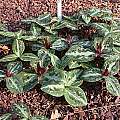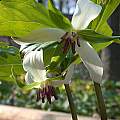Trillium is a genus in the Trilliaceae family with 43 species, with 38 in North America and 5 in Asia. The leaves, petals, and sepals come in parts of 3 and are indicative of the genus name. Plants grow from thickened rhizomes. They are mostly woodland plants that require shade and humus rich soil. Much of the information on this page supplied by John Lonsdale from his article on Trillium from Bulbs, Bulletin of the International Bulb Society, Spring 2004. The article describes many of the species of trillium found in the eastern USA and includes information on cultivation and propagation. Trillium species s through z are found on this page.
Trillium a-f - Trillium s-z - Trillium index
Trillium gracile J.D.Freeman has a narrow distribution in western Louisiana and eastern Texas, but is morphologically not particularly easy to distinguish from its nearest neighbors, Trillium ludovicianum and Trillium foetidissimum. There seems to be less variation in flower color, generally a brownish-maroon, but, highly characteristically, it does flower several weeks later than these species, often coming into flower when they are already well past their best. Photos by John Lonsdale.
Trillium grandiflorum (Michx.) Salisb. is widespread in the wild north from Tennessee to the Canadian border. It is a superb garden species, robustly growing to 15" or so with pure white flowers which fade to rose pink as they age. There are several distinct double white forms which are very beautiful. 'Snowbunting' is perhaps the best known, although it has to be searched for, and commands very high prices. Also available is a dwarf form of T. grandiflorum, perhaps only half the height of the normal plant but with quite large flowers. This appears genetically stable and common in certain locations, but it has not been formally recognized. Photos by Bill Dijk and John Lonsdale.
Photos below taken by Nhu Nguyen on the University of Minnesota campus.
Trillium hybrids are well known in the wild and cultivation, and can be very attractive plants. In Brevard, North Carolina, in a filthy ditch behind a strip mall, I have found both Trillium rugelii and Trillium vaseyi and every possible variant in between. The mixture of the large deep red-purple flower of the latter, with the white flower of Trillium rugelii makes for some lovely combinations, including true bicolors and white flowers with red veins. Photos by John Lonsdale.
Photos below were on the mystery bulbs page. Suzanne Vaughan wrote: "This trillium (actually, there are 2 of them, first 4 photos) is different than any I have. I bought it from a nursery in Tennessee. I know that white trilliums begin white and fade to pink. The red and purple bloom as red and purple. But this one, only opened on Wednesday and it opened this color. The petals almost look more like the coloring of a hellebore. The petals started out this shaded, beige, pinkish color. Last photo is a red or purple trillium, not sure, but it starts out this color." It was suggested by two sources (Robin Bell and Pamela Harlow) to be a cross between Trillium erectum and Trillium flexipes. The first source thought the last photo showed examples of the two parents. Any ideas? Is it just a strange mutation of the red or purple? (but I have 2, as far as I know right now)."
Trillium kurabayashii J.D.Freeman is from the Pacific Northwest, Northern California and Southern Oregon; its common name is giant purple wakerobin. From the name one might assume it was from Japan, however it was named for Trillium cytologist Masataka Kurabayashi, in 1975 by botanist J.D. Freeman. It grows in rich moist soils with deep humus, near the coast. It has large leaves that are distinctly mottled with dark brown or green and are slightly ruffled when mature. The flowers are sessile above leaves held horizontally. The petals are dark red purple, erect to spreading, oblong, widest near middle, often becoming twisted with age. This species is now considered to be included in Trillium angustipetalum by the Jepson Manual, but is still considered a distinct species by the Flora of North America based on differences in cytology; bract orientation, color, and texture; and petal shape. Freeman described Trillium kurabayashii as having sessile, usually acuminate bracts, longer and wider sepals, and much wider petals. The first three photos were taken by Kjirsten Wayman. The fourth photo from Elaine Allison. Seed photo by David Pilling.
Trillium lancifolium Raf. has twisted petals in many forms, but these are very long, thin and erect. It also has a unique look, taking its name from the lance-shaped leaves. The stems can be very tall, easily up to 18", and 2.5 to 3 times longer than the leaves. Flower color appears very variable, from dark maroon, through bicolors to almost green. The rhizome is also very unusual, being long and thin, and very brittle. It also tends to branch and form tight clumps more frequently than most other trilliums. In habitat it is more often found closer to small creeks, usually on the flood plain and in areas that can be totally inundated for several days or weeks in particularly wet springs. In addition to the 'normal' populations in central Georgia and Alabama, there are populations in the Florida panhandle near the Chattahoochee River which flower very early, before the end of February in many years. Photos by John Lonsdale.
Trillium ludovicianum Harb. was originally thought to be confined to the state of Louisiana, but it appears that it may well grow as far north as Chattanooga, Tennessee, where it co-exists with Trillium cuneatum. It is a more refined plant with a clearly distinct narrower petal shape but may well intergrade with Trillium cuneatum over some of its range. The range of petal colors is similar and the leaves are very attractively mottled. Photo by John Lonsdale.
Trillium luteum (Muhl.) Harb. is a large relatively invariant, yellow, flowered species, whose distribution is centered in eastern Tennessee, particularly in and around the Smoky Mountains. It is probably the most common trillium in cultivation and widely recognized. Photos #1 by Bill Dijk, #2 by John Lonsdale and #3 by Nhu Nguyen.
Trillium maculatum Raf. is another special sessile species which grows over a wide range across central Alabama, Georgia and S. Carolina. The 'maculatum' refers to the leaves, which can be strongly and darkly mottled. The flowers are usually relatively tall and a very clear red-maroon, lacking the brown overtones that flowers of many sessile species can have. Photos by John Lonsdale.
Trillium nivale Riddell is known as the Snow Trillium; it is by far the earliest flowering trillium here and a wonderful showy plant. Absolutely hardy, as might be expected as its heartland in the wild centers on Indiana, Illinois and Iowa where it frequently gets covered in snow whilst flowering and seems immune to being frozen solid. Here in SE Pennsylvania it flowers in early to mid-March, long before most trilliums are even through the ground. The flowers are pure white to creamy-white, of heavy texture and prominently veined, and replete with beautiful golden yellow anthers. Although it is typical of the pedicellate trilliums in that its leaves are unmarked, they are unique in that the best forms have leaves which are a wonderful shade of blue-green, overlaid with a pewter cast, often with the veins picked out with silver speckles. Photo by John Lonsdale.
Trillium ovatum Pursh has white short oval petals on a long pedicel that become rose colored with age and sharp pointed green leave. It is found in moist shady woods and slopes from Monterey, California along the coast north to British Columbia. Banana slugs may play an important role in germination of the seeds by removing the eliaosomes and leaving the seeds behind. Plant in deep rich soil in a shady spot or one with filtered sun. This species will tolerate water all year long, but does not require summer water. Seed is best planted as soon as it is ripe and kept moist until it germinates. Patience is required as it may take 5 to 7 years before plants reach flowering size. Once you have plants, if you are lucky, you will find new seedlings in other parts of your garden. It is shown below in the first two photographs from Bob Rutemoeller showing Oxalis oregana in Kruse Rhododendron State Park in Northern California on May 1, 2003. The next two photos are from Mary Sue Ittner. The last shows a form with spotted leaves found in coastal Mendocino County that is not recognized by The Plant List but was named Trillium forma maculosum Case & R.B.Case. It was described in Flora of North America as having bracts blotched or spotted dark maroon or maroon green markings on the upper surface of the leaves. The last photo from Jill Peterson shows a form flowering in Metchosin, Canada.
The first two photos from Mary Sue Ittner show a new flower after it rained and the fruit and the third from Bob Rutemoeller shows the fruit breaking apart with seeds before they are dispersed.
Trillium parviflorum V.G.Soukup. is considered by Plants of the World Online to be a subspecies of [[TrilliumSpeciesOne#albidum|Trillium albidum. It is a small but striking plant. It is found between the Coast Range and the Cascades in the northern half of Oregon and the southern half of Washington. These trilliums are often associated with stands of Quercus garryana (Garry oak) and Symphoricarpos albus (snowberry), in fairly moist situations. Mature plants are 10 to 20 cm high, with roundish leaves 10 cm long. Photos by Dave Brastow.
Trillium pusillum Michx. is a beautiful species which tends to flower rather early for a pedicellate trillium. It occurs in several widely disjunct populations west from eastern Maryland to the Ozarks of Missouri, south to western Texas and then back east through Alabama and Georgia into S. Carolina. It is always very charming, dwarf (3" – 12") and has an upwards facing white flower. The flower often has ruffled margins and, in the manner of Trillium grandiflorum, fades to rose pink as it ages. The foliage of some forms is almost purple in color until it matures to a deeper green. In the wild it is frequently found in seasonally boggy or even swampy areas, but doesn't require such conditions in cultivation. Photos by John Lonsdale.
Trillium recurvatum L.C.Beck is easily identified with its petiolate leaves, recurved sepals and relatively short petals. It has a similar color range to Trillium lancifolium, although is normally a brownish-maroon to red-maroon. It has a very wide range in the central United States for a sessile trillium and can be quite variable in size, petal color and leaf marking. The first 3 photos were taken by John Lonsdale. The last photo by Russell Stafford shows the mottled leaves.
Trillium reliquum J.D.Freeman is an almost decumbent plant, the leaves sitting on or just above the forest floor. It is native to Alabama, Georgia, and South Carolina. It is superficially like Trillium decumbens at first sight but differs in a number of features, particularly its non-pubescent stem. Photos by John Lonsdale.
Trillium rivale S.Watson is now considered to be a synonym of Pseudotrillium rivale (S.Watson) S.B.Farmer.
Trillium rugelii Rendle which has a distribution centered on the southern Appalachian mountains of Virginia and the Carolinas will often form small clumps of 3-5 stems. The stamens are purple and the ovary is also purple or white with a purple stigma. The flowers remain relatively non-showy because the flowers are hidden by the leaves. Photo by John Lonsdale.
Trillium a-f - Trillium s-z - Trillium index

